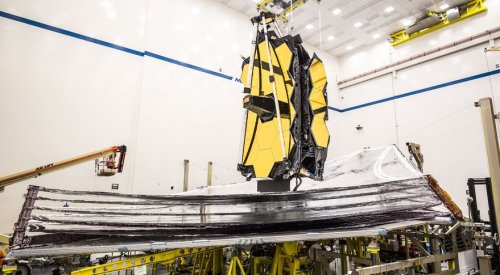WASHINGTON — NASA has suspended work on the James Webb Space Telescope as it prioritizes what agency missions require people to be on site during the coronavirus pandemic.
In a statement March 20, NASA Administrator Jim Bridenstine said NASA had completed an assessment of work across the agency, deciding which projects are essential enough to require people to go to NASA centers or other facilities to work on them.
“We are going to take care of our people. That’s our first priority,” said Bridenstine. “Technology allows us to do a lot of what we need to do remotely, but, where hands-on work is required, it is difficult or impossible to comply with [Centers for Disease Control and Prevention] guidelines while processing spaceflight hardware, and where we can’t safely do that we’re going to have to suspend work and focus on the mission-critical activities.”
JWST, NASA’s next astrophysics flagship mission, is one of the projects that NASA is putting on hold. Work on integration and testing of the space telescope, which had been ongoing at a Northrop Grumman facility in Southern California, will be suspended.
“Decisions could be adjusted as the situation continues to unfold over the weekend and into next week,” NASA said in its statement. “The decision was made to ensure the safety of the workforce. The observatory remains safe in its cleanroom environment.”
During an online town hall meeting for NASA’s science program earlier March 20, Thomas Zurbuchen, NASA associate administrator for science, suggested the mission would be delayed. “It will be impacted,” he said. NASA personnel involved in that work had been reduced, he said, in part to allow those on travel to return home to their families.
“That will lead to changes in our schedule,” he said. “It’s anticipated that, by early April, the Webb project will be experiencing day-for-day scheduling impact to its critical path.”
Another factor is the decision by California Gov. Gavin Newsom to issue a statewide “shelter in place” order, closing businesses other than those deemed essential. NASA, in its statement, said it was assessing the effects of that order on work at the Jet Propulsion Laboratory.
NASA is moving ahead with the Mars 2020 mission and its Perseverance rover, which the agency has given a high priority because of its narrow launch window that opens in mid-July. In the statement, NASA said that “launch and other mission preparations will continue” for the mission, reiterating similar statements in recent days by NASA’s science leadership.
“The teams are doing, frankly, heroes’ work to keep us on track for a July launch,” Zurbuchen said. He added there had been discussions with NASA’s Armstrong Flight Research Center and Wallops Flight Facility, both of which host NASA aircraft, about using those planes to fly “necessary personnel” to the launch site if other modes of transportation, like commercial aviation, are not available. “It’s something we refer to amongst ourselves as ‘Perseverance Airlines,’” he said.
While work on the Space Launch System and Orion has been suspended at the Michoud Assembly Facility and Stennis Space Center, NASA said “limited production of hardware and software” for SLS continues elsewhere. The Orion spacecraft built for the Artemis 1 mission, which recently finished environmental testing at NASA’s Plum Brook Station in Ohio, is still scheduled to be flown back to the Kennedy Space Center soon.
Other human spaceflight programs are continuing. Mission Control for the International Space Station at the Johnson Space Center is operating with unspecified “additional measures” in place to reduce controllers’ risk of exposure to COVID-19. NASA astronaut Chris Cassidy, who will launch to the station April 9 on a Soyuz spacecraft, will go into quarantine two weeks before launch, standard procedures for any crewed mission.
Work on the commercial crew program continues, with NASA calling it “a critical element” for safe ISS operations. Plans for future cargo missions are also unaffected.
Most other programs, however, are shifting to virtual activities. Zurbuchen said at the town hall meeting that missions in the early stage of development can essentially do all of their activities, like design work, remotely, and thus can proceed.
Missions that do need hands-on work and are prevented from doing so will suffer delays, he acknowledged. “Just like in a government shutdown, which we have seen before, that will have consequences,” he said. “We’ll deal with that later.”
Zurbuchen said he would not hesitate to stop work on Mars 2020 if it was unsafe to do so, even if it meant missing its launch window and having to wait until 2022 to try again. “Every time we have a meeting with the JPL center director and contractors, I reassure to them if there’s a moment in time when they feel it’s no longer safe,” he said, “we will stop.”
- DoD memo: Suppliers of critical products and services must stay on the job during pandemic
- Coronavirus pandemic to halt SLS testing
- Long-awaited space sustainability guidelines approved by UN committee
- NASA imposes cost caps on astrophysics flagship studies
- Why Sierra Nevada’s owners are betting big on Dream Chaser
Share with your friends

(0) Comments
This article comments are currently no :(